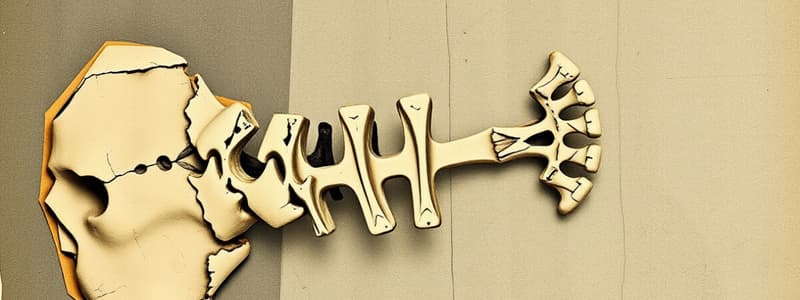Podcast
Questions and Answers
What is spongy bone?
What is spongy bone?
Made up of trabeculae, it is found in flat, short, irregular, and sesamoid bones, and is located at the epiphyses of long bones, closely associated with red bone marrow.
What is compact bone?
What is compact bone?
A type of bone tissue that has very few spaces and coats the exterior of all bones; it makes up the majority of the diaphysis of long bones.
What are trabeculae?
What are trabeculae?
The flat plates of bone found in spongy bone that form the spaces where red bone marrow is located.
What is an osteon?
What is an osteon?
What is the central canal?
What is the central canal?
What are concentric lamellae?
What are concentric lamellae?
What is bone matrix?
What is bone matrix?
What are lacunae?
What are lacunae?
What are osteocytes?
What are osteocytes?
What are canaliculi?
What are canaliculi?
What are perforating canals?
What are perforating canals?
What are osteogenic cells?
What are osteogenic cells?
What are osteoblasts?
What are osteoblasts?
What are osteoclasts?
What are osteoclasts?
Study Notes
Microscopic Structure of Bone
-
Spongy Bone: Composed of trabeculae, primarily found in flat, short, irregular, and sesamoid bones; located at the epiphyses of long bones. Associated with red bone marrow.
-
Compact Bone: Dense bone tissue with minimal spacing, covering all bones' exterior. Major component of the diaphysis in long bones.
-
Trabeculae: Flat plates of bone forming the structure of spongy bone, creating spaces for red bone marrow.
-
Osteon (Haversian System): Functional unit of compact bone consisting of concentric lamellae, lacunae, canaliculi, central canals, and perforating canals.
-
Central Canal: Central part of an osteon that houses blood vessels, nerves, and lymphatic vessels within compact bone.
-
Concentric Lamellae: Layers of bone matrix arranged concentrically within an osteon, contributing to its structural integrity.
-
Bone Matrix: Solid substance composed of inorganic salts like calcium and phosphorus, making up the majority of compact bone tissue.
-
Lacunae: Small spaces within the bone matrix that contain osteocytes, the mature bone cells.
-
Osteocytes: Mature bone cells responsible for bone's daily metabolic functions, situated in lacunae.
-
Canaliculi: Tiny canals extending from lacunae that facilitate the transport of nutrients, oxygen, and waste between osteocytes and blood supply.
-
Perforating Canals (Volkmann's Canals): Tunnels that cross osteons transversely, accommodating blood vessels, nerves, and lymphatic vessels in compact bone.
-
Osteogenic Cells: Unique bone cells capable of division and production of new bone cells, crucial for bone growth; located deep in the periosteum, endosteum, and central canals.
-
Osteoblasts: Bone-forming cells that secrete bone matrix by utilizing calcium from the bloodstream; found deeper in the periosteum and endosteum.
-
Osteoclasts: Cells responsible for bone resorption, breaking down bone matrix to release stored calcium into the bloodstream. Modified white blood cells located in the endosteum.
Studying That Suits You
Use AI to generate personalized quizzes and flashcards to suit your learning preferences.
Description
This quiz focuses on the microscopic structure of bone, specifically the characteristics of spongy and compact bone. Explore key definitions and features that differentiate these two types of bone tissue in the skeletal system.




